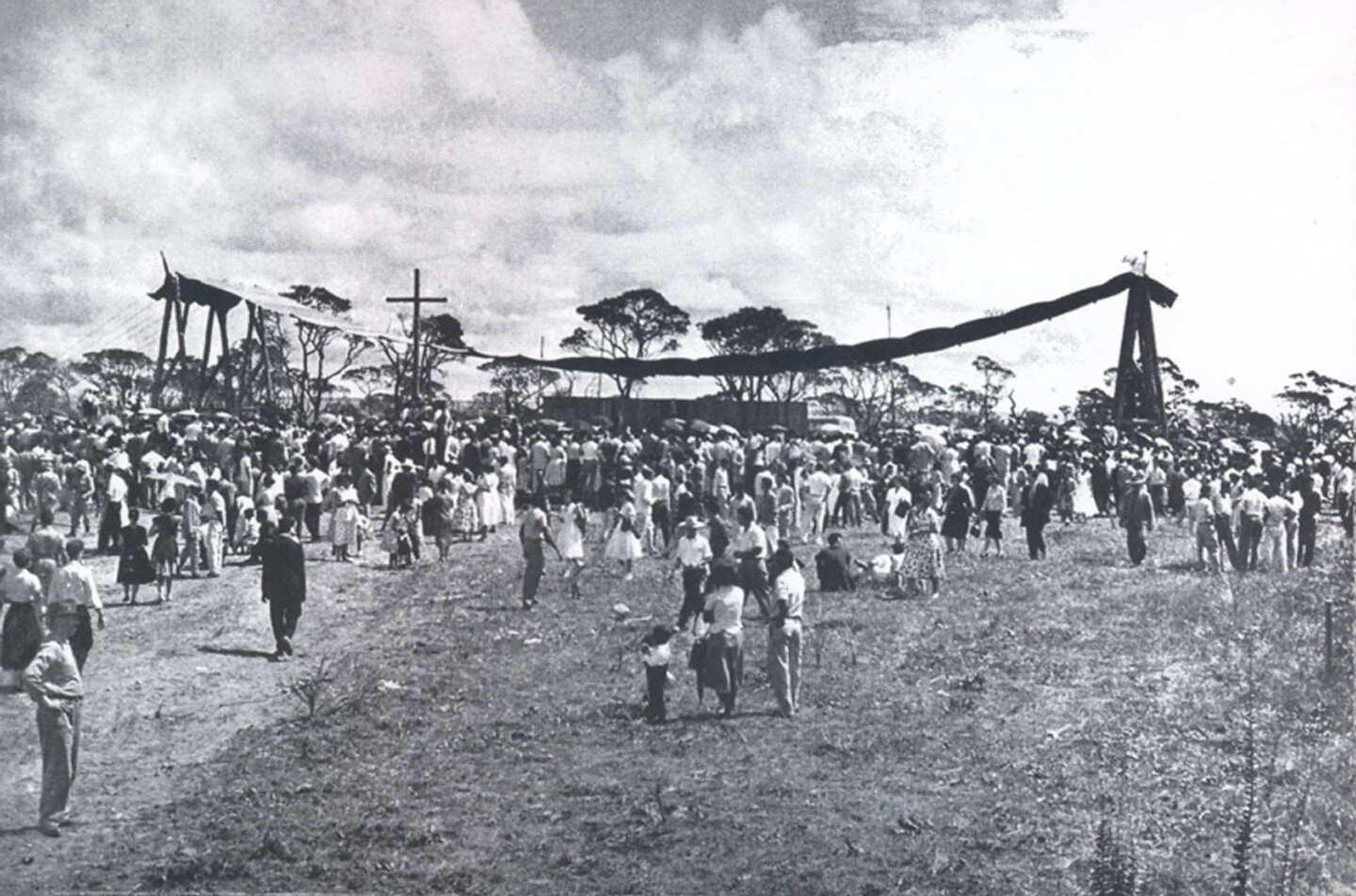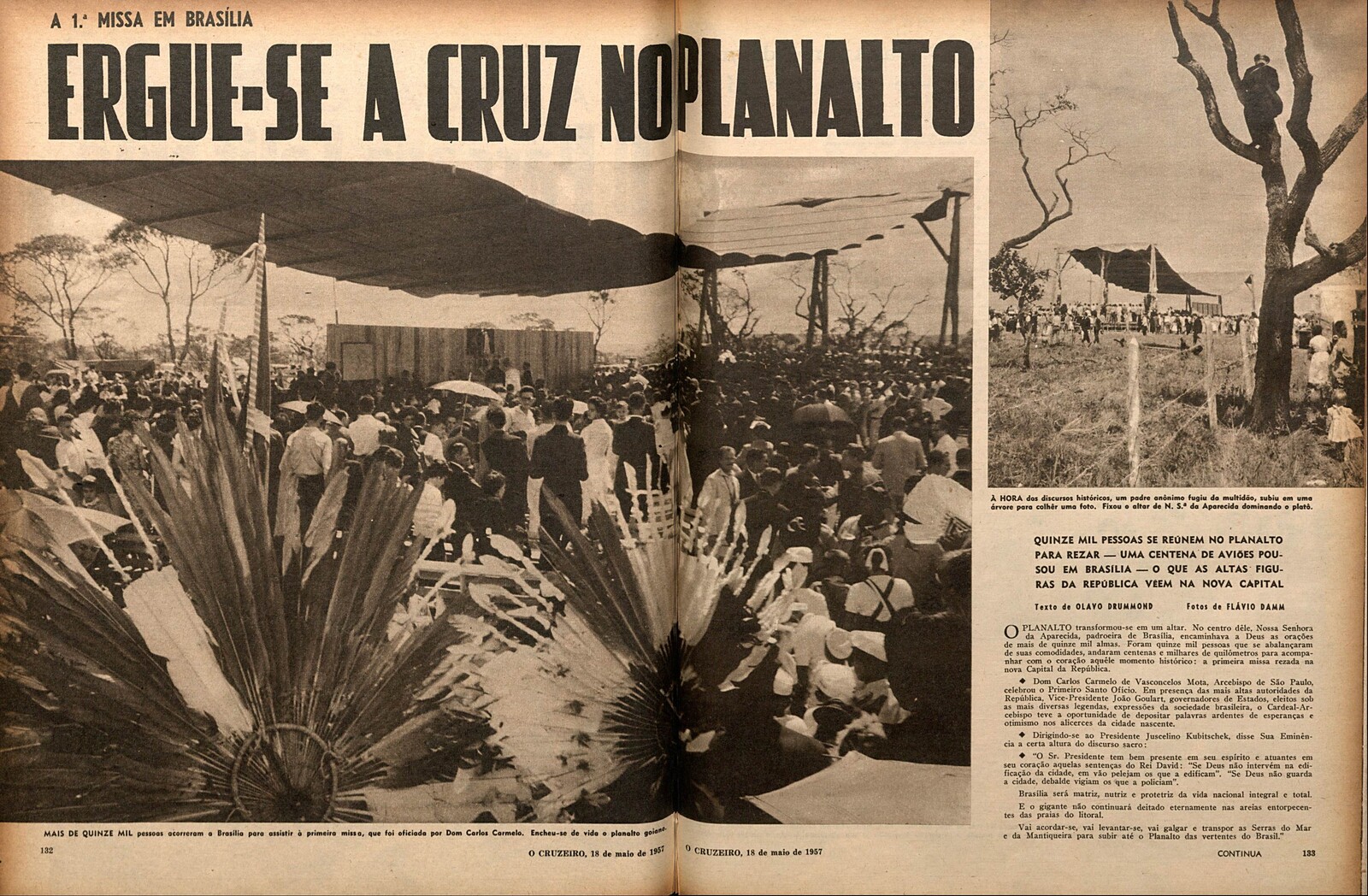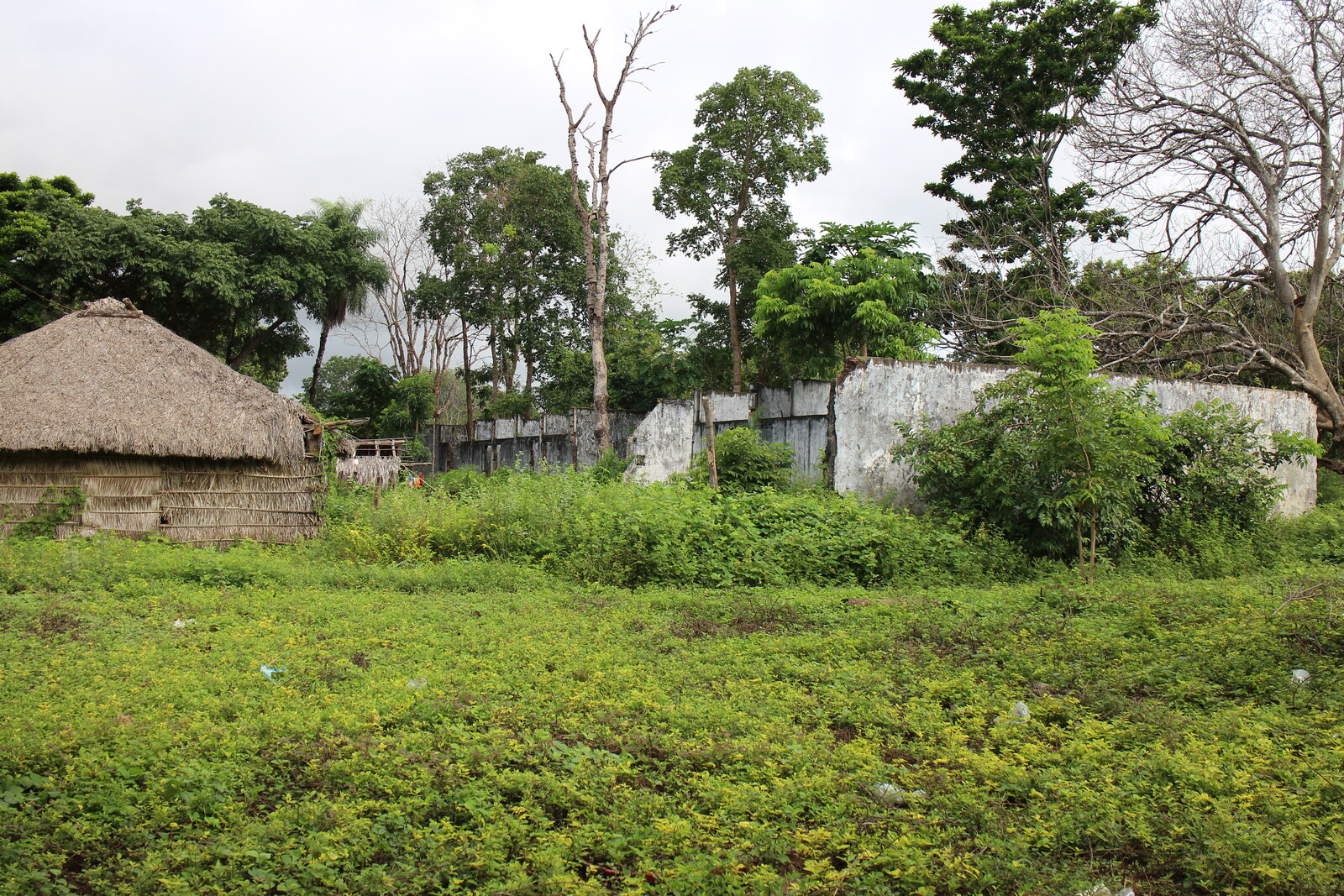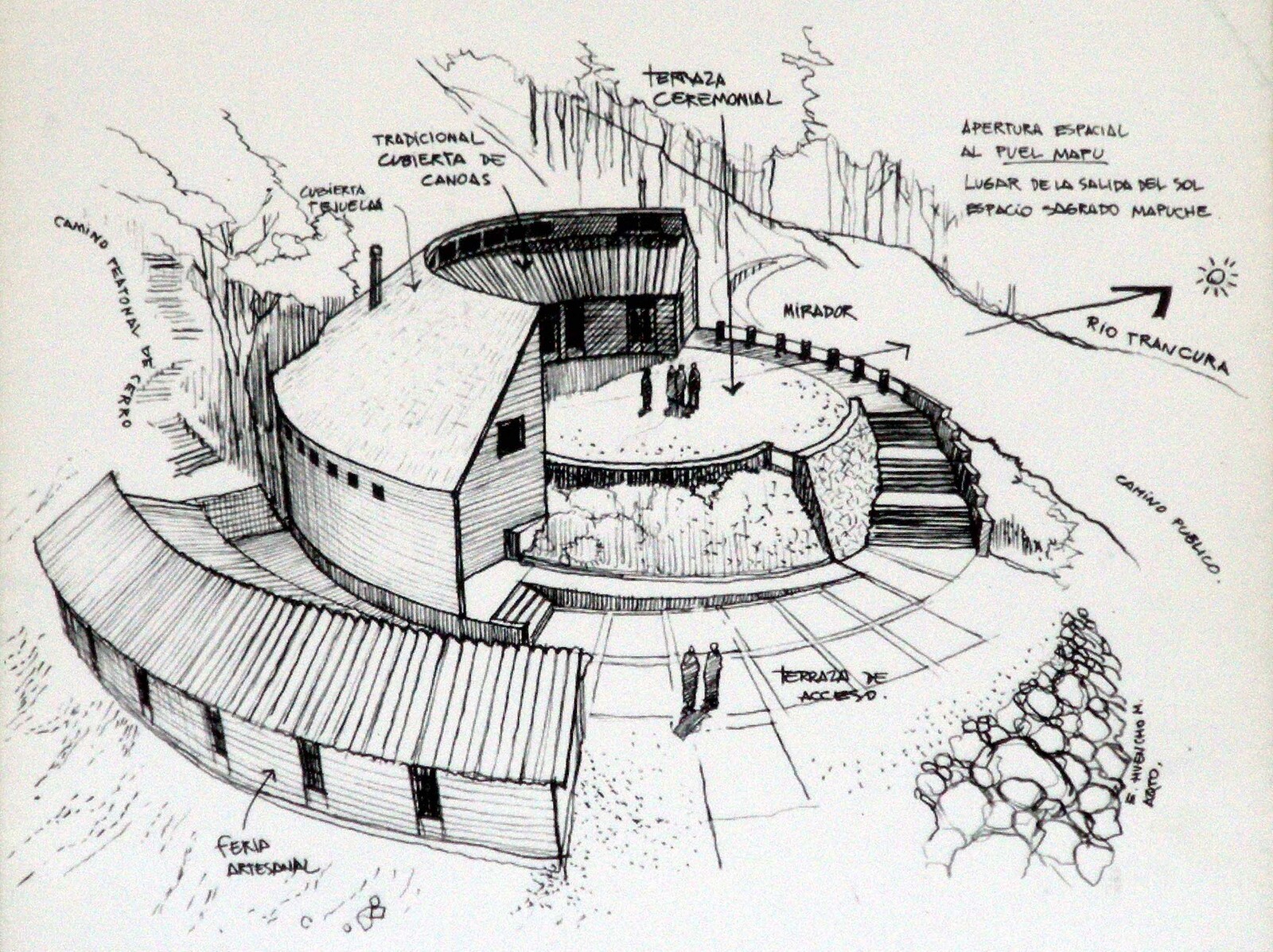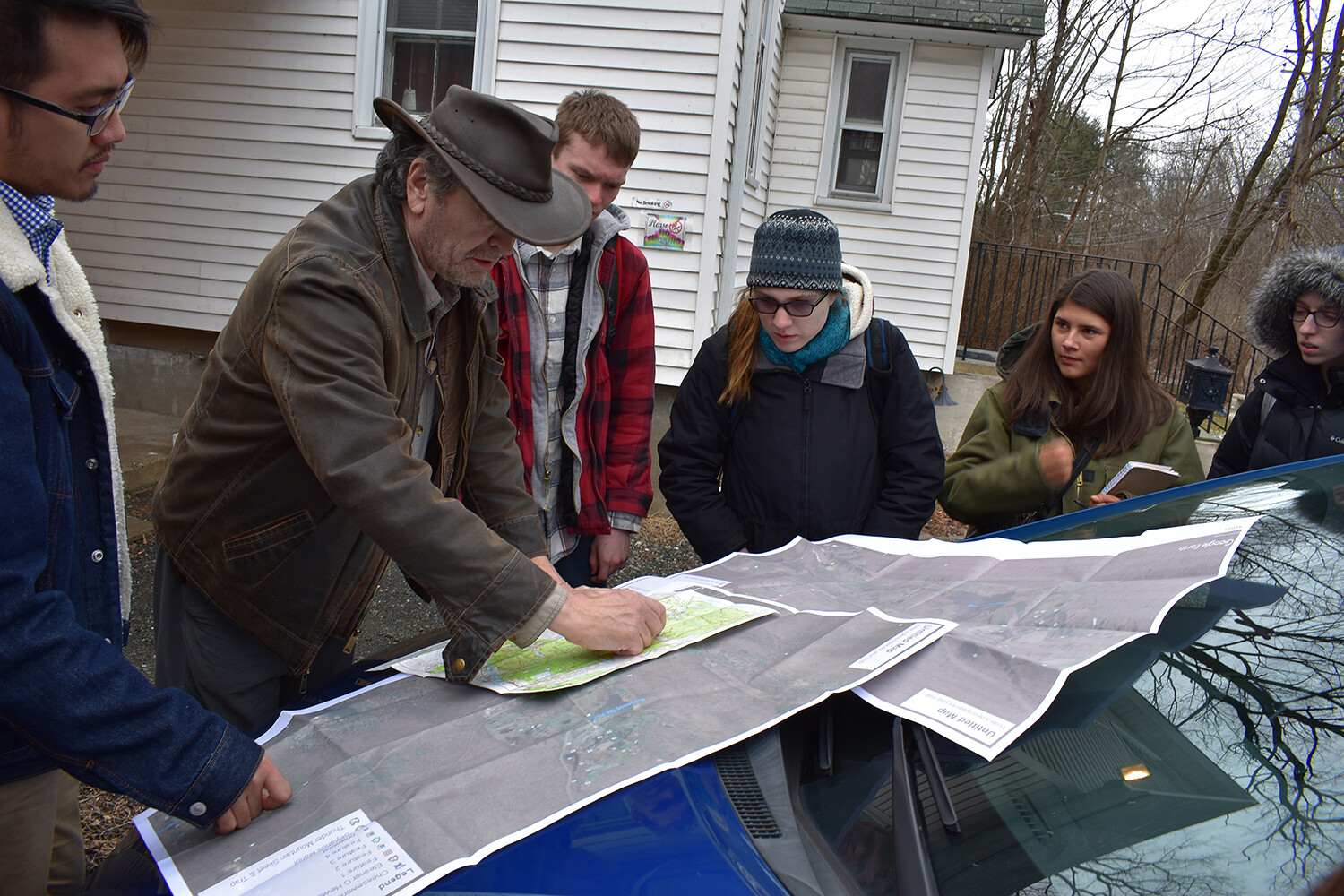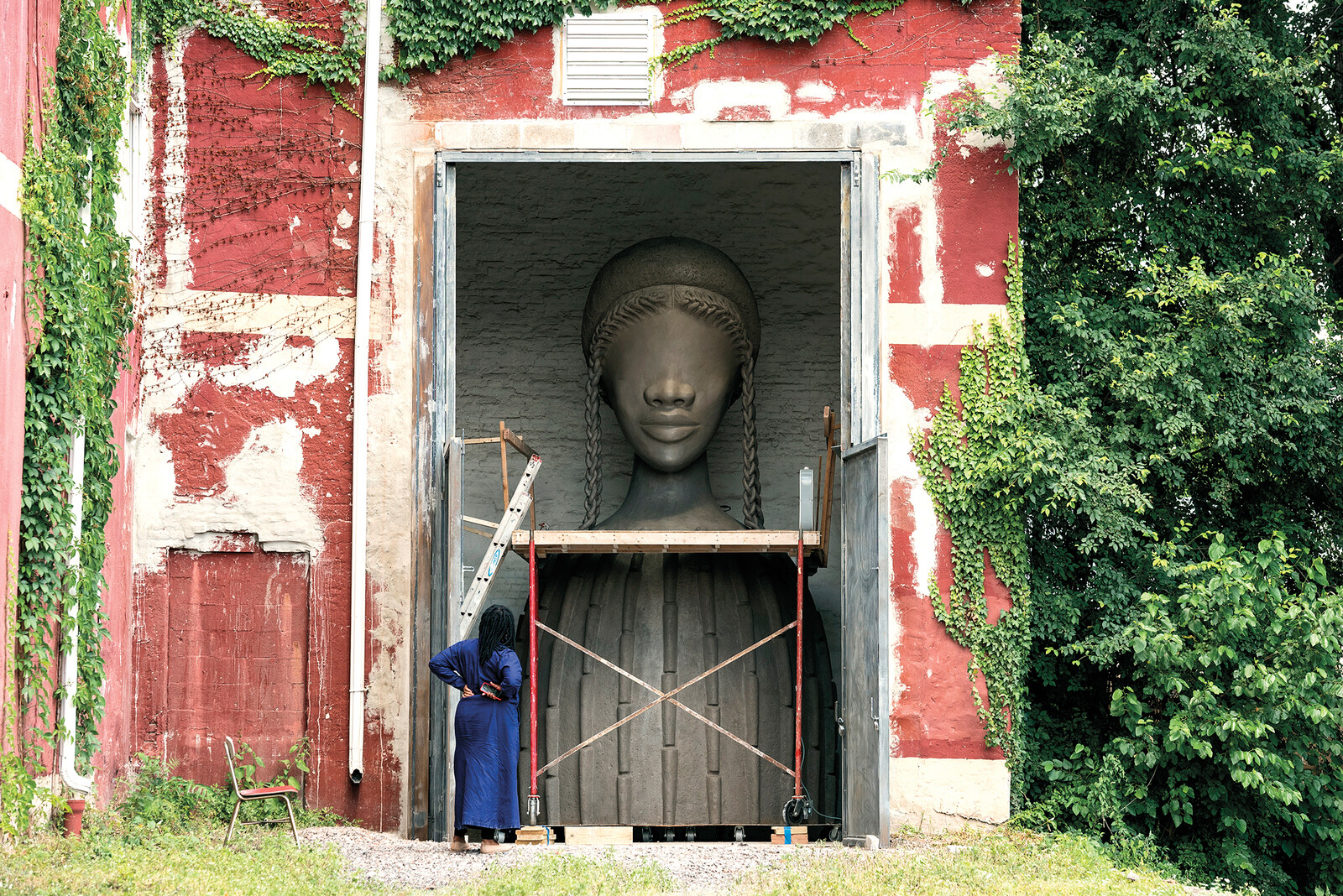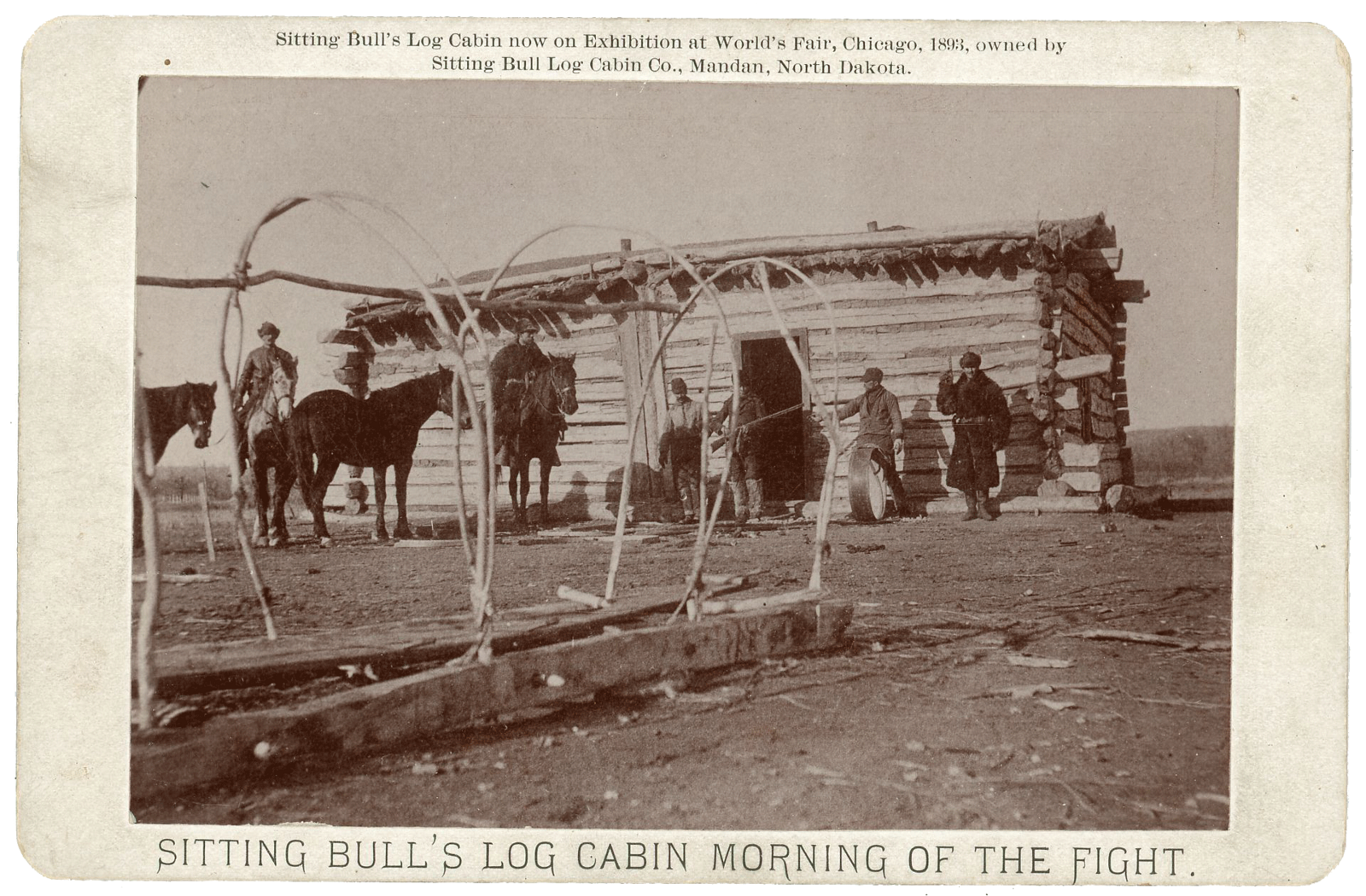In the wake of the contra-monument protests led by the Black Lives Matter movement, I made a post on a social media group of the architecture school of the University of Brasília, a public university where I teach in Brazil, proposing a discussion with students about the role of colonial racism in the modernist landscape memorialized in Brazil’s celebrated state capital. Meant to initiate a pedagogic conversation in the academic-digital environment in the context of the Covid-19 pandemic, the post was quickly picked up by a city magazine, circulating through digital networks.1 In between some positive and mostly negative public responses to my proposal of interpreting Brasília as a colonial monument that needs to be dismantled, I was particularly taken by commentaries accusing a pedagogic initiative of an attempt to “erase” and “revise” history, and most concerning in the current political situation in Brazil—when public university teachers are being politically targeted for manifesting ideas contrary to the far-right nationalism of Jair Bolsonaro’s government—the allegation that I was “indoctrinating” my students.2 This text was originally written and published in Portuguese as a public response to this context, aiming at opening up a debate in Brazil.3 It questions the imaginary around Brasília, the modernist-colonial capital which celebrates its sixtieth anniversary this year, and outlines why colonialism is a structural and continuing process of the ideologies of nation-building in Brazil.
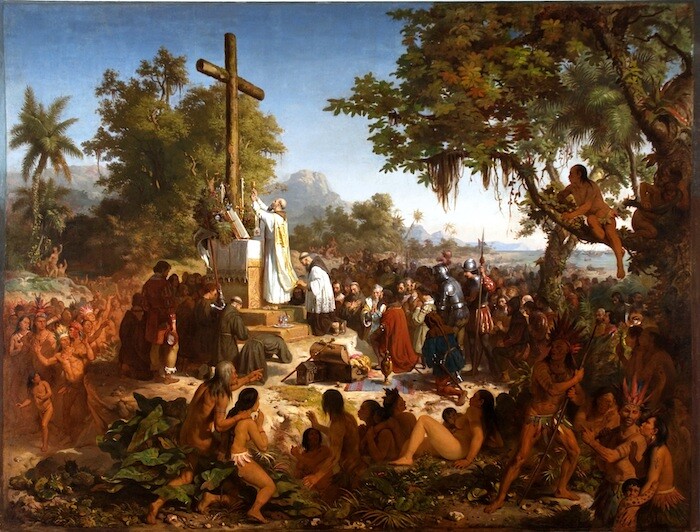

Victor Meirelles, Primeira Missa no Brasil (First Mass in Brazil), 1861.
“The cross rises”
“I chose the date 3rd of May because it seemed the most expressive, since it recalled the mass celebrated by Pedro Álvarez Cabral,” wrote president Juscelino Kubitschek about the Catholic mass celebrated in 1957 to mark the foundation of the construction site of Brasília, Brazil’s new state capital. “The two ceremonies were equivalent in symbolism.” From the Vatican, Pope Pius XII sent a special message to celebrate the occasion: “On the anniversary of the discovery and the first mass in the lands of Santa Cruz, we are very pleased that such important date is remembered with the celebration of the first mass in Brasília.”
A historical landmark of the construction of the new capital, the “First Mass in Brasília” was carefully designed to evoke the mass celebrated in 1500 by the Cabral fleet on the beach of Coroa Vermelha, southern of Bahia, which symbolically marked the possession of the Amerindian territories by the Portuguese Empire. The intention of Kubitschek was to re-enact not so much the event itself, but an image of the event, as immortalized in Victor Meirelles’s 1861 painting First Mass in Brazil. In its foreground, we see a large cross made of tree trunks and the colonizers praying around it. In a lower plane, a crowd of Indigenous people observes the ceremony with a mixture of astonishment, awe, and reverence. Tropical nature sets the scene.
To achieve this image-effect, a whole mise-en-scène was created at the construction site of Brasília. Designed by Oscar Niemeyer, the altar was rustic and minimalist. Its wooden structure and a tensioned canvas cover translated the “primitive” setting of the colonial conquest like a frontiersman camp into modernist language. A large wooden crucifix rose above the tent, setting a vertical mark against the flat savannahs of central Brazil, demarcating the possession of territory as European conquerors once did. Political, religious, and military authorities from all regions of Brazil were present. To complete the performance, president Juscelino Kubitschek ordered the Brazilian Air Force to bring a delegation of Karajá people from Bananal Island to attend the mass. “With their characteristic features and adornments,” reported the magazine Brasília, the official state-propaganda media about the new capital, “they were the picturesque note of the ceremony.”4
A colonial tradition
The “First Mass in Brasília” was foremost a photographic event, orchestrated to be registered by modern media such as newspapers, magazines, and cinema. It sought to propagate an imaginary of national modernity that was in continuity with the European invasion of Amerindian territories. Just like the Indigenous people represented in Victor Meirelles’s painting, the Karajá were called to represent the supporting actors in a script that heroically portrayed the theft of their lands and the domination of their people. This modernist theatre was filled with symbolic violence.
In the same way that it is impossible to dissociate European imperialism from the genocide of Indigenous peoples, it is difficult to grant the capital the patrimonial interpretation of modernity and national-racial integration it supposedly represents. In its material and immaterial landscape, Brasília continues to memorialize colonialism, aligning the history of the conquest of the Americas with sentiments of nationalism, while silencing the violence that this represents.
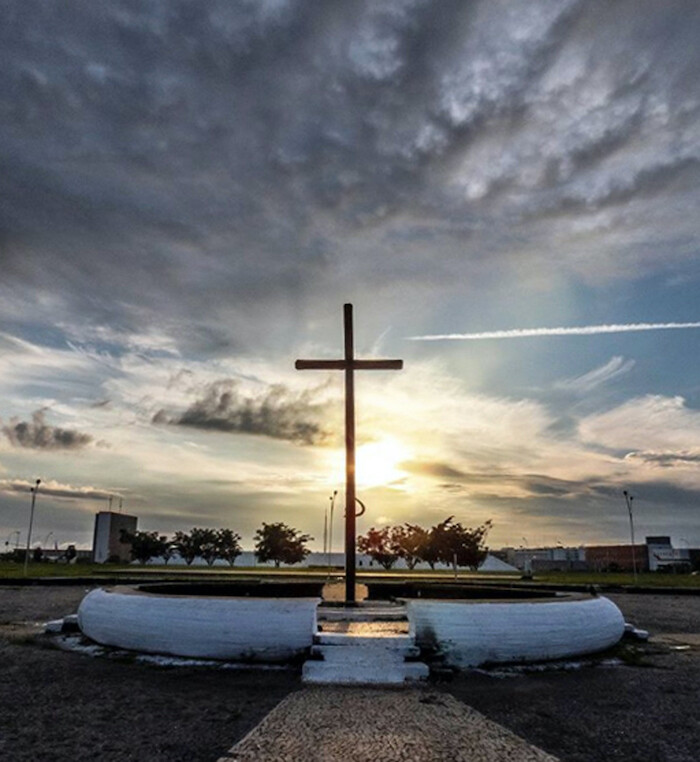

Crucifix Square, Monumental Axis, Brasília. Instagram post by @minhacapital, April 9, 2020.
Today, in the place where the “First Mass” was celebrated—at the head of the so-called “Monumental Axis,” the main entrance to the state capital—there is a replica of the crucifix used in 1957 (the original is on public display at the Metropolitan Cathedral). Next to “Crucifix Square” it is the “JK Memorial,” a monumental mausoleum designed by Niemeyer that houses the mortal remains of Juscelino Kubitschek. The mortuary chamber is surrounded by a tile panel designed by Athos Bulcão and covered with a stained glass by Marianne Peretti. Engraved in the tomb’s granite is the insignia “The Founder.” Next to it, the film O Bandeirante by Jean Manzon, a pioneer of photographic modernism in Brazil, didactically teaches the public the meaning of this modernist funeral scenography, contextualizing the persona of “JK” within a historical lineage where conquerors figure as the great authors of national construction.
Since the “First Mass” is a founding event in the historical narrative of Brasília, and because it is the memorial site that opens the architectural narrative of the Monumental Axis, the replica of the crucifix functions to encode the symbolic message of the entire urban setting of the state capital. It places the modern landscape that slowly unfolds until the Praça dos Três Poderes—the “Square of the Three Powers,” where the headquarters of the nation’s legislative, judicial, and executive power are located—within a historical trajectory whose origins are grounded in colonialism. The public is called upon to learn—and more than that, to share and condone—the idea that the national modernity represented by Brasília acquires full meaning only when observed in continuity with territorial colonization, the manifest destiny of a nation that “marches towards the west.”5


O Bandeirante (1957), film by Jean Manzon shown next to Juscelino Kubitschek’s grave at the JK Memorial.
Here it is important to elucidate the meaning of the term bandeirante that gives the title to Jean Manzon’s film exhibited at the JK Memorial, whose possible translation to English is akin to “frontiersman.” Notorious for their violence, bandeiras were paramilitary explorations in colonial Brazil with the objective of capturing Indigenous peoples to be traded as slaves and search for minerals. Commanded by European descendants, they were responsible for waging war on native groups as well as free communities of fugitive Black enslaved peoples called quilombos. They were also responsible for opening routes to the gold-rich interiors of central Brazil, thereby expanding the territorial sovereignty of the Portuguese Empire over the continent.
In the official version of Brazilian national history, the bandeiras and the men that led them, the bandeirantes, came to assume a heroic, mythical status. This legacy can in large part be attributed to the strategic investment that the Brazilian state made in the narrative of frontier expansionism as an image of national identity and progress through various means of political propaganda and cultural production, including the arts, photography, cinema, and architecture. Exhibited next to Kubitschek’s mortuary chamber, Jean Manzon’s film O Bandeirante presents another version of this colonial myth of nation-building, situating Brasília as a modernist manifestation of this frontier ideology.
When experiencing this landscape (I moved to Brasília about three years ago to teach architecture at the federal public university), one feels confronted with a question that can no longer be avoided: which historical landmarks in the urban fabric of Brazil’s modernist capital, a city-monument in itself, commemorate colonial-racial violence as if they were heroic stories of national-racial unity and democracy? Should the monumentalized imagery of bandeirante exploring and occupying the hinterland frontiers be interpreted as symbolic landmarks of modernity, or documents of colonial barbarism? As Walter Benjamin has taught us, they are both at the same time.6
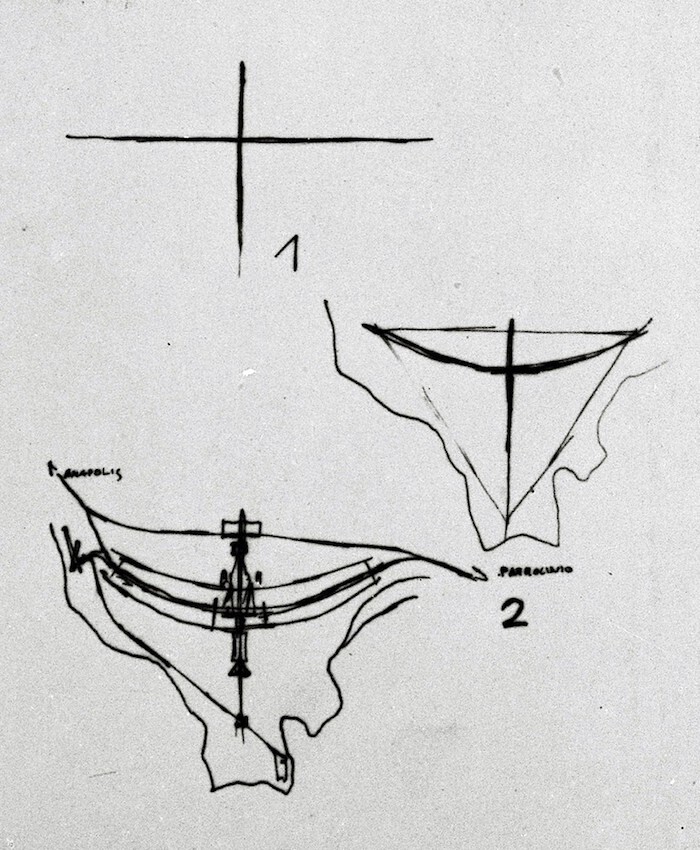
Lúcio Costa’s original sketches of Brasília’s masterplan, “a gesture along the lines of colonial tradition. […] two axes crossing at right angles, that is, the sign of the cross itself.”

Opening of the highway axes that define Brasília’s “pilot plan,” ground zero of the new capital, 1957. (Mario Fontenelle/Public Archive of the Federal District.)

Aerophotogrammetry of the pilot plan under construction, “chamfering the sign of the cross in the ground”, as described by Mário Pedrosa. (Brasília magazine no. 19, July 1958/Fundo Novacap—Public Archive of the Federal District).
Lúcio Costa’s original sketches of Brasília’s masterplan, “a gesture along the lines of colonial tradition. […] two axes crossing at right angles, that is, the sign of the cross itself.”
The entire memorial symbolism of this landscape brasiliana is based on the bounds between modernity and coloniality established through these and other monuments that are found across Brasília’s urban fabric. Architect Lúcio Costa, the author of Brasília’s masterplan, attributed the design to “a deliberate act of possession … a gesture still in the sense of the pioneers, along the lines of the colonial tradition … two axes crossing at right angles, that is, the sign of the cross itself.” This is the symbolic-urbanist foundation of the so-called “pilot plan” of Brasília, whose spatial layout follows the design of a cross. The metamorphosis of the cross into an airplane flying towards progress, as many interpret, is one of many symbolic constructions of the relationship between colonialism and modernity in the national formation of Brazil that is so well represented by Brasília.7
Further, it is interesting to note how the monumental dimension of colonialism embodied in Brasília’s crucifix urban design—a kind of land-art at a territorial scale—is apprehensible only when viewed from an external and distant perspective, manufactured by modern means of landscape representation such as photographic cameras coupled to aircrafts or satellite images.
Disseminated through the visual power of public architecture and reiterated by photography, magazines, newspapers and cinema, Brasília’s colonial narrative became a founding myth of national modernity in Brazil, reproduced across the entire political-ideological spectrum, left and right, by both democratic and dictatorial regimes. Even someone like critic and curator Mario Pedrosa, known for his work on art and politics in alignment with the left, came to corroborate this narrative, identifying in colonialism the radical aesthetic gesture that gives Brasília its universal singularity. The originality of Lúcio Costa’s urban design, Pedrosa wrote, was due to the “recognition that the only possible solution was still on the basis of the colonial experience, that is, taking possession like Cabral has done, carving the sign of the cross into the land.”8
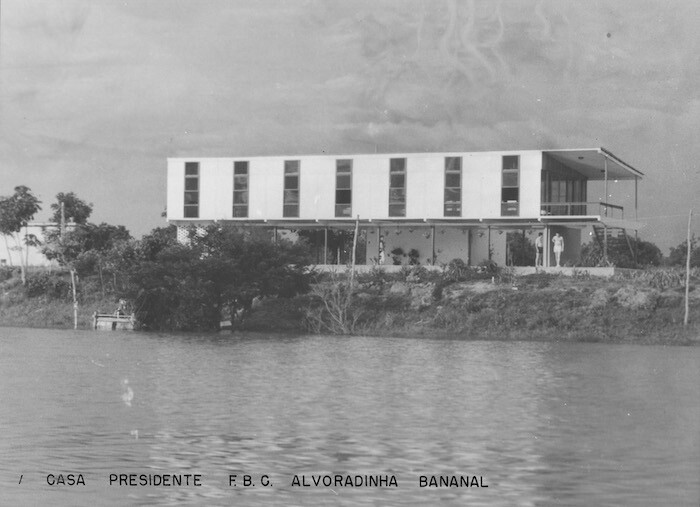

Juscelino Kubitschek’s house in the complex of Hotel JK designed by Oscar Niemeyer, Bananal Island, ancestral Karajá territory (Fundação Brasil Central archive, courtesy Public Archive DF).
Colonial beyond the symbolic
Brasilia’s modernist affiliation with colonialism goes beyond the symbolic dimension. For many Indigenous nations, especially for the Karajá, who live a few hundred kilometers north from Brasília, the construction of the new capital meant the continuation of a secular process of colonization and territorial dispossession, but now legitimized under discourses, images, and imaginaries of national modernity and racial integration.
The Karajá delegation brought from the Bananal Island to attend the “First Mass in Brasília” lived around an “Indigenous Station” of the Indian Protection Service (SPI), a state agency created in 1910 with the mission of “pacifying” and “integrating” the Indigenous populations of Brazil.9 In the context of the governmental program “March to the West,” a state campaign of frontier expansion implemented by the dictatorial regime of Getúlio Vargas (1937–1945), the Brazilian Air Force installed a base next to SPI’s station, which was then named “Indigenous Station Getúlio Vargas.” Taking advantage of this infrastructure, Kubitschek transformed the Bananal Island into a national park and commissioned Oscar Niemeyer to design a luxury tourist hotel named “Hotel JK” for the political elites and state bureaucracy that would come to live in Brasília.
Such state policies stimulated all sorts of invasions into Karajá territory and caused devastating impacts for the ecological and cultural sustainability of these communities. By the mid-1960s, Bananal Island had been occupied by so many cattle farms that, as an anthropologist who visited the region at that time witnessed, the Karajá villages were literally confined into their own lands by barbed wire fences: “There are never funds to fence the pasture. The only cheap solution is to fence the village, giving it the air of an internment camp designed to keep the Karajá in rather than the cattle out.”10
This discourse that aligns modernization and colonialism represented by Brasília served state power to legitimize developmental projects that throughout the second half of the twentieth century, especially during the US-backed military dictatorship (1964–1984), had ethnocidal and genocidal consequences for the Indigenous populations of Brazil. General Golbery do Couto e Silva, the military regime’s great geopolitical strategist, interpreted Brasília as a “platform” from which to launch a new “occupation and integration front” over the Amazon forest. Translated into numerous plans, projects, and architectures, this policy of militarized colonization, as reported by the Brazilian National Truth Commission, was responsible for the forced removal and killing of thousands of Indigenous people.11
The memorialization of colonialism in Brasília served and still serves as a legitimating image/discourse to this type of state policy, which gains new force with the current far-right government of president Jair Bolsonaro, projecting the image that national development is associated with a kind of “internal colonialism.” Without being questioned, these monuments empower these narratives, causing the violence of this discourse to be naturalized, silenced, and, above all, continued in the present.
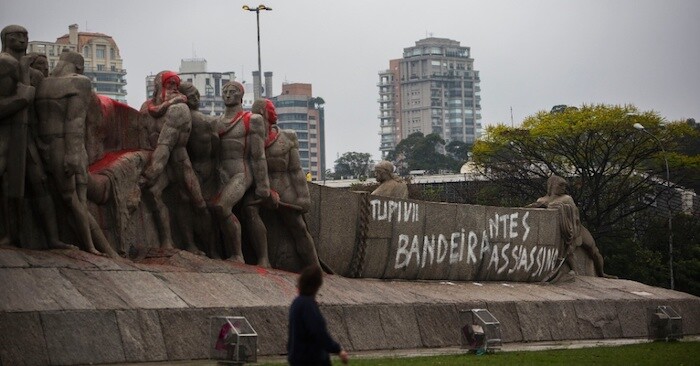

Intervention at the Monument to the Bandeira, a modernist landmark designed by Victor Brecheret, during indigenous protests in 2013 in São Paulo. Image by Apu Gomes/Folhapress.
Counter-monuments
In the past months, statues of slave traders and colonizers have been removed and defaced in various cities in the United States and Europe. When questioning the monumentality that celebrates colonialism and racism, anti-racist and anti-colonial movements situate memory and the right to memory in public spaces as a territory in dispute, open to re-appropriations and re-significations that contest the official history that these landmarks commemorate.
At various moments in history, monuments have been challenged when social forces questioned established regimes of power. French revolutionaries not only beheaded Louis XVI, but also destroyed statues of monarchs throughout France.12 In Mozambique’s independence in 1975, the prominent equestrian statue of the Portuguese military officer Joaquim Augusto Mouzinho de Albuquerque that decorated the colonial capital Lourenço Marques was removed to a museum, and the city was renamed Maputo.13
Contra-monument movements call into question how certain narratives perpetuate forms of oppression through objects made for public display and reverence. Observed over time since monuments were erected, the ways in which they manifest—defacements, mutilations, destruction, and removals—are in themselves public memorials, for they are as representative landmarks of social history as the monuments against which they invest claim to be.
Yet the activist tactics that Black Lives Matter and other movements utilize, which include symbolic-performative actions that sometimes involve objective violence against monuments, are often denounced as attempts to “erase” or “attack” history. We certainly cannot delete, edit, or pretend that we have another history, but we can demand that the history we have is narrated as another one that does not perpetuate the forms of oppression that are communicated by these public monuments.
In the Brazilian context, the debate about the removal/reframing of monuments that celebrate colonialism has been an important agenda of social movements, especially in relation to those which celebrate the bandeirantes. In the city of São Paulo, for instance, the sculpture Monument to the Bandeiras by Victor Brecheret is considered a landmark of modern national art. The bandeiras were responsible for the massive enslavement and killing of indigenous and black peoples, but the identity of São Paulo continues to be celebrated in affiliation with this genocidal history through sculptures and names of streets, roads, squares, and avenues.
In October 2013, during a large march for Indigenous and quilombola rights, protesters occupied the Monument to the Bandeiras and threw red paint over the sculpture, symbolizing the bloodshed of Indigenous and Black bodies that were enslaved and annihilated by the bandeirantes. The public reaction of the cultural elites was immediate, and many came out in defense of “national heritage” against “vandalism.” In 2017, when the monument was again defaced, Victor Brecheret’s heir compared it to terrorist actions and characterized it as an “onslaught against civilization.”14
The protesters who organized this performative act, many of them daughters and sons of ancestral Guarani generations who live in the territory now known by the colonial-Christian name of Saint Paul, have a completely different position on the meaning of such monuments in the city’s public landscape. As Marcos Tupã wrote at the time, instead of making room for a discussion about the monument’s re-signification, the mainstream media preferred to report the protest “as if it had been a depredation of something that whites consider to be a work of public art and heritage.” Tupã’s words reveal how the colonialism memorialized in these modern objects is not something from the past, but extends itself in a continuum with concrete situations in the present:
The red paint that for some of you is defacement has already been cleaned and the monument has returned to paint as heroes the genocidal men of our people. Unfortunately, however, we know that the massacres that took place in the past against our people and that continue to take place in the present have not ended with this symbolic act and will not cease anytime soon. Our relatives remain forgotten on the side of the roads … they continue to be threatened and murdered at the behest of rural politicians who, with the silent connivance of the State, steal land and dignity of those who survived the attacks of the bandeirantes. Also in São Paulo this massacre continues, and close to you, we live confined in tiny lands, with no conditions for survival. This is vandalism.15
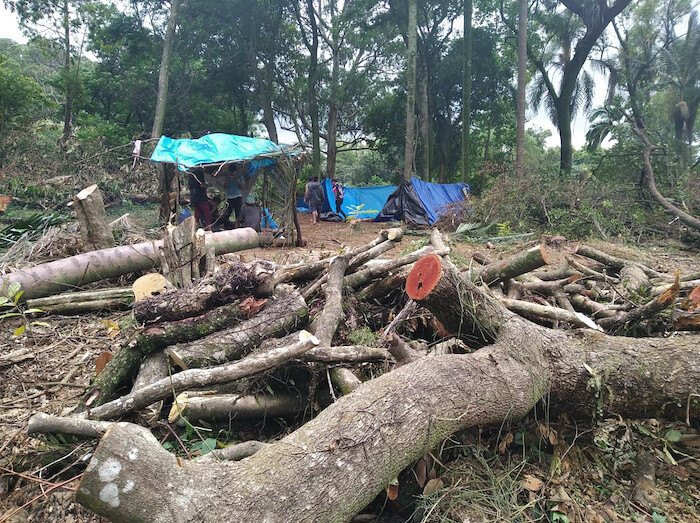

Guarani activists occupy an area deforested by the real state company Tenda at Pico do Jaraguá, São Paulo, Guarani ancestral land. Photo by Terra Indígena Jaraguá.
…and other such stories
Inspired by the anti-racist and anti-colonial movements that are challenging the monumentality of hegemonic history, in celebrating its sixty-year anniversary in 2020, Brasília has a unique opportunity to confront the memorialization of colonialism in its own urban landscape and re-signify images and narratives of national modernization and historic heritage. This is of course a national/local question as much as it is a global/international question that addresses the historical complicities of modern architecture with settler colonialism.16
Instead of celebrating Brasília as a frontier landmark of national modernity, we should reflect on how certain memories are eternalized while others are erased, and seek to trace new memorial cartographies in its urban fabric. This implies that narratives communicated through archives, images, arts, and architecture should be deconstructed and re-signified by a wide and inclusive debate with the most diverse segments of society, especially those whose memories have been neglected. In this sense, it is not enough to promote “plural narratives” of monuments, since it is not a question of different perspectives on history, but of historical reparation.17
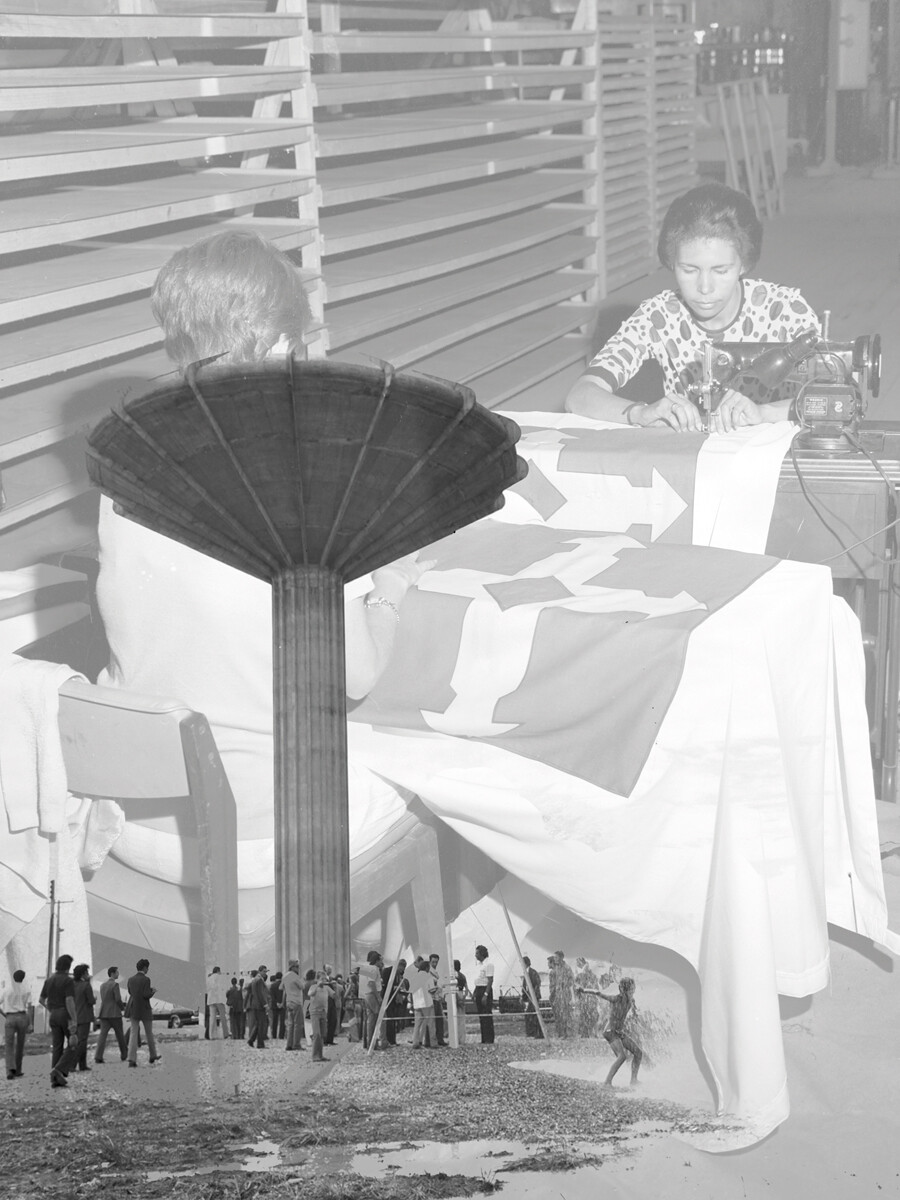
Exhibition panels of Repossession: Narratives of Black Presence in the History of the Federal District, National Museum of Brasília, 2019. Editing by Diego Soares with photographs by unknown authors / Public Archive of the Federal District—ArpDF.
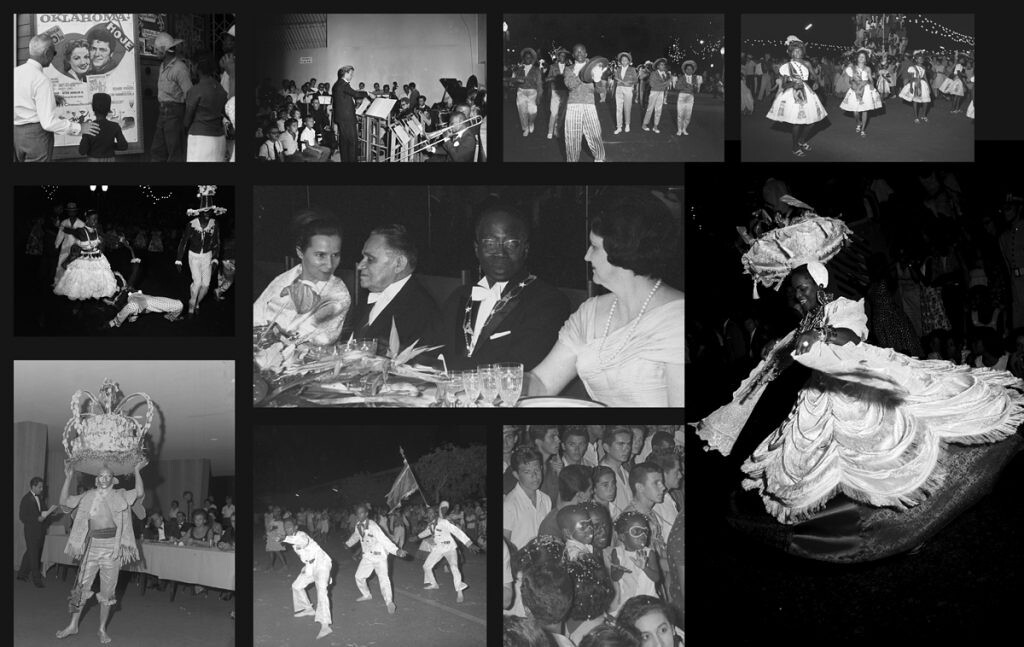
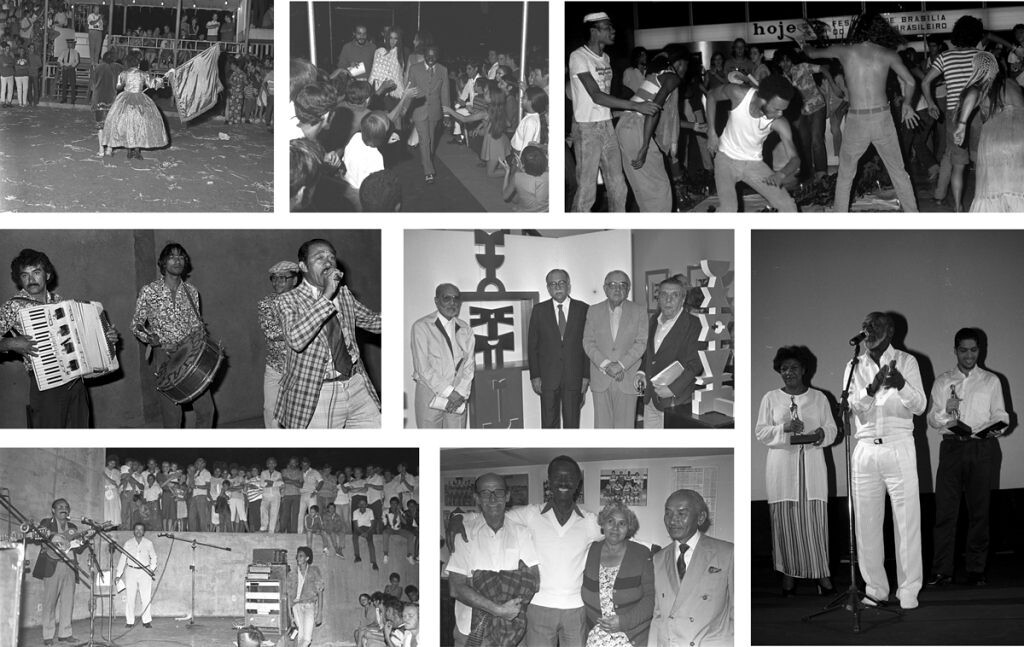
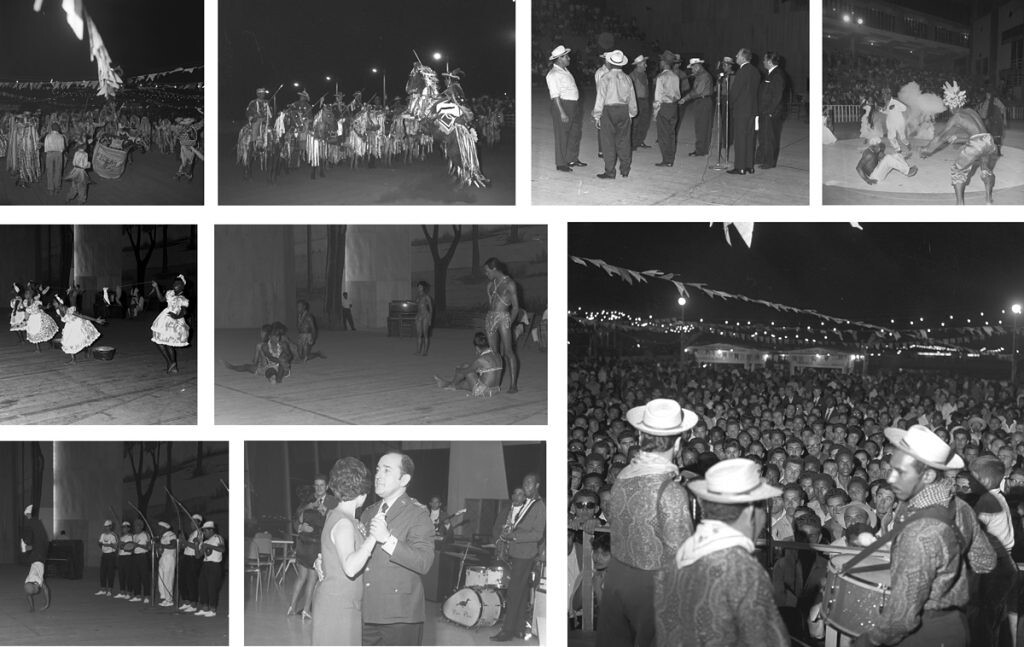
Exhibition panels of Repossession: Narratives of Black Presence in the History of the Federal District, National Museum of Brasília, 2019. Editing by Diego Soares with photographs by unknown authors / Public Archive of the Federal District—ArpDF.
Initiatives such as the exhibition “Repossession: Narratives of Black Presence in the History of the Federal District” at the National Museum of Brasília have sought to problematize the official imagery/ideology about Brasília, offering the public access to another city. As curator Ana Flávia Magalhães Pinto argues, “what we saw over time was the denial of the black presence in the images of the construction of Brasília.”18 The exhibition invited the public to learn about the state capital beyond this historical process of denial and whitening of its memory. Through a detailed archeology of the visual archives of Brasília—one of the most photographed cities in the world since its construction—the exhibition revealed not only the centrality of the Black presence in the history of the new capital, but also how the imaginary around the city erases that presence. More than that, the exhibition invited the public to recognize and acknowledge that long before president Kubitschek declared himself “the founder” of civilization in the “desert lands” of the Brazilian frontier, the region where Brasília is located is ancestral quilombo territory, historically occupied by free and autonomous communities of fugitive enslaved African peoples and their descendants.
There is a direct relationship between the memory that is visible, denied, or erased in public spaces and the continuity of practices of oppression, state violence, and structural racism. In recent years, the quilombo Kalunga—one of the largest in the country, about 300 kilometers north of Brasília—and the quilombo Mesquita—located less than fifty kilometers south of the capital—have confronted a series of attacks on their territorial rights. In 2018, a government resolution approved the reduction of more than 80% of the original territory of quilombo Mesquita.19 And in 2020, in the middle of the COVID-19 pandemic, a huge area of the Kalunga territory was illegally deforested to advance soy plantations.20 Similar forest areas that remain around the Guarani villages in the Jaraguá Indigenous Territory in São Paulo are being threatened by real estate projects.21 These are the true acts of vandalism, defacing and disfiguring the ancestral memorial heritage that these lands represent.
For past violence and violations to not be repeated, it is necessary to deepen the debate on historical reparations, which includes the re-signification of heritage narratives that celebrate racial colonialism in Brasilia, São Paulo, and so many other Brazilian cities. This inevitably implies the removal or re-signification of monuments. The construction of the Memorial of the Indigenous Peoples next to the JK Memorial in 1987, an initiative that reflects the protagonist role of the Indigenous movement in the post-dictatorship re-democratization process, serves as a counterpoint to the narrative of modern colonialism celebrated by the state capital. But there is certainly more to be done, here in Brazil and elsewhere.
Caio Barbiere, “UnB: arquitetos contestam monumentos ligados à violência. Lista tem até JK,” Metrópoles, June 10, 2020, ➝.
There are many cases that could be mentioned. For example, various episodes of extreme-right hackers invading digital environments of public university classes have been reported in Brazil. Usually they aim at disturbing classes by flooding the digital environment with hate speech messages accusing teachers of left-wing indoctrination, ➝. President Jair Bolsonaro’s intelligence service produced a secret dossier about hundreds of public servants identified as members of “anti-fascist movements,” including renowned public university professors like Paulo Sérgio Pinheiro of the University of São Paulo, who holds an international reputation as a human rights defender and presided the Brazilian National Truth Commission, ➝. There have been cases of public university teachers that had to leave the country because of death threats, such as feminist anthropologist professor Débora Diniz of the University of Brasília, internationally known for her research and activism on women’s reproductive rights, ➝.
Paulo Tavares, “A capital colonial,” Zum, July 28, 2020, ➝.
Brasília no. 5, May 1957, ➝.
“March to the West” was the official name of the state program of frontier expansionism implemented by the dictatorial regime of Getúlio Vargas (1930–1945).
Walter Benjamin, “Über den Begriff der Geschichte (On the concept of history),” 1940. Published in Walter Benjamin zum Gedächtnis, eds. Max Horkheimer and Theodor Adorno (Los Angeles: Institute for Social Research, 1942).
A significant example of the cross-airplane metaphor-metamorphosis—that is, of the colonialism-modernism symbolic link—is articulated by art critic Mario Pedrosa in this way: “Lúcio Costa’s wisdom consisted in accepting the incongruity inherent in the program, and, avoiding any mid-way or eclectic solution, resolutely deciding on the inexorable side, given the immediate objective conditions: the full recognition that the only possible solution was still at the basis of the colonial experience, that is, a taking over of Cabraline fashion, carving on earth the sign of the cross, or, in a more ‘modern’ and optimistic evocation, making the shape of an airplane to land sweetly on its surface.” Mario Pedrosa, “Reflexões em torno da nova capital (Reflections on the new capital),” Revista Brasil: Arquitetura Contemporânea no. 10, 1957.
Ibid.
The “pacification” and “integration” of indigenous population is a policy whose origins are grounded in colonialism, particularly in the colonial practices of religious orders such as the Jesuits. Such practices developed more fully as state policies under the liberal paradigms of nineteenth-century discourses of civilization, and continued to be employed until the late twentieth-century by state agencies. See: João Pacheco de Oliveira, O nascimento do Brasil e outros ensaios: “pacificação,” regime tutelar e formação de alteridades (Rio de Janeiro: Contra Capa. 2016). “Integration” has a similar genealogy, and was particularly instrumental during the military dictatorship (1964–1984). Bolsonaro’s government is currently resorting to the same ideologies of “integration” elaborated by the military.
Christopher J. Tavener, “Introduction to the Karajá and the Brazilian Frontier,” in Peoples and Cultures of Native South America, ed. Daniel R. Gross ((Garden City: Natural History Press for The American Museum of Natural History, 1973).
“Violações de direitos humanos dos povos indígenas,” Volume 2, Text 5, in Relatório da Comissão Nacional da Verdade (Brasília: Comissão Nacional da Verdade, 2014), ➝.
Andrew McClellan, “The Life and Death of a Royal Monument: Bouchardon’s Louis XV,” Oxford Art Journal 23, no. 2 (2000): 3–27.
Noticiário Nacional de 1975, “Derrube estátua de Mouzinho de Albuquerque,” aired May 21, 1975, on RTP 1, ➝.
Adriana Farias, “Filho de Brecheret vê ligação entre pichação e último debate eleitoral,” Veja São Paulo, June 1, 2017, ➝.
Marcos Tupã, “Monumento à resistência do povo guarani,” Ybirupa Comissão Guarani, October 2013.
Brasília’s American mirror is, in many different ways, Chicago: both are midwest frontier modern-colonial cities constructed upon the dispossession of indigenous lands and class-racial segregation whose identity is defined by modernist architecture—modernist architecture being instrumentalized as an ideological veil to legitimate and silence the colonial-racial structures upon which modernism and modernity were built.
Contemporary activisms that challenge monuments and memorials are associated with the broad agenda of historical reparations. They should be contextualized in relation to other debates that seek to problematize the role of colonial-racism in the field of arts, architecture and heritage, as for example in the recent discussions on the restitution of objects that were systematically looted from Africa and the Americas to be exposed in European museums.
Conceição Freitas, “Brasília, uma cidade para brancos construída pelos pretos,” Metrópoles, October 27, 2019, ➝.
Débora Brito, “Quilombo a 50 km de Brasília luta para manter território e identidade,” Agência Brasil, June 16, 2018, ➝.
Simone Kafruni, “MPF apura desmatamento do território quilombola Kalunga em Cavalcante,” Correio Braziliense, June 12, 2020, ➝.
Caroline Oliveira, “Povo Guarani impede ação de construtora que quer fazer 5 prédios no Pico do Jaraguá,” Brasil de Fato, February 6, 2020, ➝.
The Settler Colonial Present is a collaboration between e-flux Architecture and the Settler Colonial City Project, with the support of the Department of the History of Art and Taubman College of Architecture and Urban Planning at the University of Michigan.
